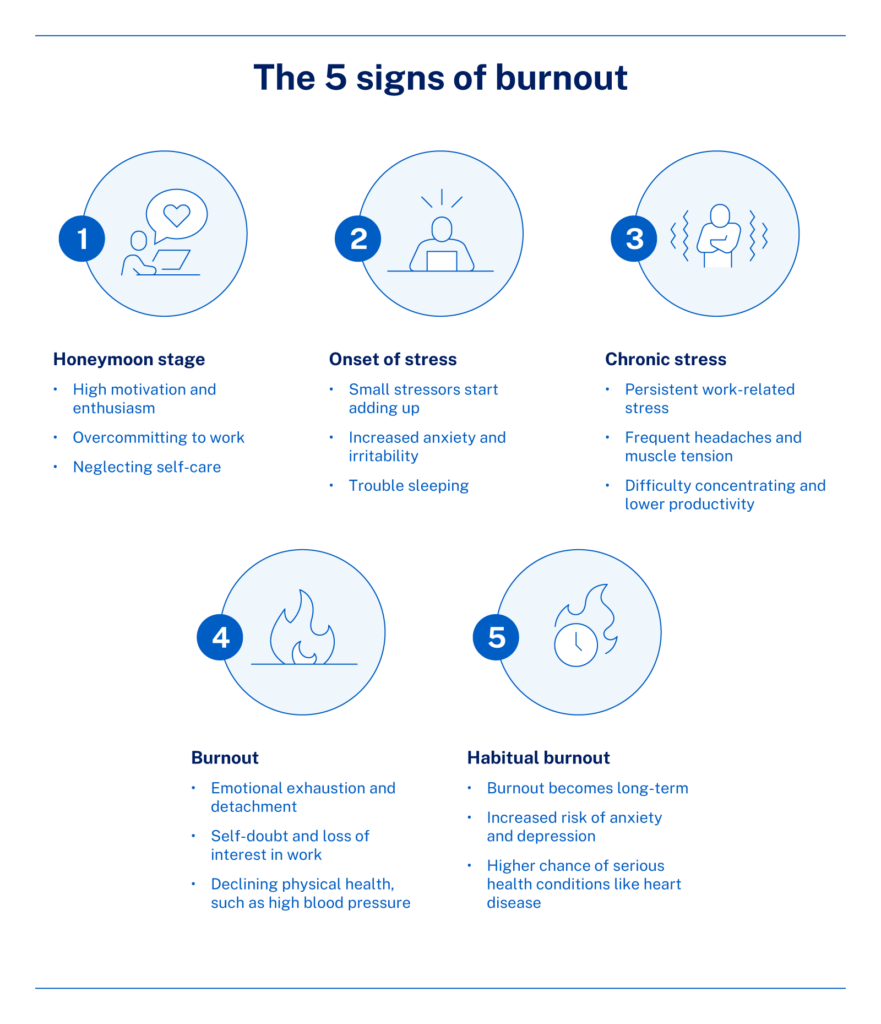What is burnout?
Burnout is a state of chronic physical, mental, and emotional exhaustion caused by prolonged work-related stress, leading to reduced performance and well-being. First studied by psychologist Herbert Freudenberger in 1974, burnout has since been linked to serious long-term effects on mental and physical health.
Unlike temporary stress, burnout gradually wears down a person’s energy and motivation, affecting multiple areas of life, including work, relationships, and personal well-being. People experiencing burnout sometimes struggle with feelings of detachment, reduced performance, and a lack of fulfillment in their roles.
The effects of burnout can manifest physically through chronic fatigue, headaches, and weakened immunity, making it more than just a mental burden.
The World Health Organization now recognizes burnout as an occupational phenomenon, linking it to chronic stress that has not been successfully managed. If left unaddressed, burnout can lead to serious health conditions, decreased productivity, and high turnover rates.
This way, burnout is not the same as simply feeling overworked or tired. While a good night’s sleep can alleviate normal exhaustion, burnout persists even with rest and self-care. It can lead to severe consequences if left unaddressed, such as anxiety, depression, and decreased job satisfaction.
That’s why recognizing the symptoms and stages of burnout early on can help deal with and prevent further damage to the employee. In the following topics, we’ll delve deeper into these concepts.
What are the causes of burnout?
Burnout is often the result of prolonged workplace stress, unrealistic expectations, and an imbalance between professional responsibilities and personal well-being.
It develops gradually, often without clear warning signs, until emotional exhaustion and physical symptoms become overwhelming. Certain industries, work environments, and personality traits make some individuals more vulnerable than others.
Some of the most common causes of burnout include:
- Long hours and overwork. Jobs that demand excessive time commitments and have little room for breaks or recovery increase the risk of burnout.
- Chronic stress. Persistent stressors at work, such as tight deadlines, unrealistic expectations, and high-pressure environments, can lead to emotional exhaustion.
- Toxic workplace stress. A negative work culture, lack of support from colleagues or leadership, and unclear job roles can contribute to mental and physical burnout.
- Demanding work environments. High-stakes industries, such as healthcare, caregiving, and emergency services, have some of the highest burnout rates due to emotional strain and intense workloads.
- Personality traits. Perfectionists, high achievers, and individuals who have difficulty setting boundaries are more prone to burnout.
- External stressors. The COVID-19 pandemic amplified burnout for many workers, increasing workloads, uncertainty, and the struggle to balance professional and personal responsibilities.
Understanding the root causes of burnout is essential for both individuals and organizations. By addressing these stressors early, employers can create healthier work environments, and employees can take proactive steps to safeguard their well-being.
The five signs of burnout

Burnout develops in stages, progressing from early work-related stress to full emotional exhaustion and depersonalization. Recognizing the following common signs of burnout can help individuals take preventive action before serious health conditions develop:
1. Honeymoon stage
At the start of a new job or role, motivation is high, and stress levels are manageable. Enthusiasm can mask the early warning signs of burnout, such as overcommitting to work or neglecting self-care.
Common experiences during this stage include:
- Optimism about future growth and development within the role.
- High energy levels and willingness to take on additional responsibilities.
- Strong desire to make positive impressions on colleagues and supervisors.
- Genuine excitement about learning new skills and contributing to the organization.
2. Onset of stress
Small stressors begin to accumulate, leading to increased anxiety, irritability, and difficulty sleeping. Individuals may start to feel overwhelmed but still push through their workload.
Warning signs during this phase include:
- Reluctance to start the workday or frequent clock-watching.
- Decreased patience with colleagues or clients.
- Beginning to skip breaks or work through lunch to keep up with demands.
- Mild physical symptoms like tension headaches or jaw clenching.
3. Chronic stress
Work-related stress becomes persistent, causing noticeable effects on mental and physical health. Symptoms such as frequent headaches, muscle tension, and difficulty concentrating appear, and productivity may start to decline.
Physical and psychological indicators include:
- Persistent fatigue that isn’t relieved by regular sleep.
- Increased susceptibility to illnesses due to weakened immune function.
- Difficulty making decisions or solving problems that were once manageable.
- Withdrawal from social activities and workplace engagement.
4. Burnout
Emotional exhaustion and depersonalization set in, making work feel meaningless and draining. Individuals may struggle with self-doubt, loss of interest in their jobs, and a decline in energy levels. Physical health also deteriorates, with a higher likelihood of developing conditions such as high blood pressure and immune system issues.
At this point, individuals commonly experience:
- A sense of failure and self-doubt despite previous accomplishments.
- Detachment from colleagues and decreasing empathy toward clients or customers.
- Increased absenteeism or presenteeism (physically present but mentally disengaged).
- Development of negative coping mechanisms like increased alcohol consumption or emotional eating.
5. Habitual burnout
Burnout becomes a long-term condition, significantly impacting mental health, job performance, and personal relationships. At this stage, serious health conditions such as depression, anxiety, and even heart disease can develop.
Long-term consequences often include:
- Career regression or stagnation due to decreased performance and motivation.
- Development of serious clinical conditions requiring medical treatment.
- Loss of personal and professional support networks through isolation.
- Significant impact on life satisfaction and overall quality of life.
The symptoms of burnout: recognizing the warning signals
Burnout can manifest through physical, emotional, and behavioral symptoms, making it important to recognize the warning signs before they escalate. These symptoms can affect daily life, work performance, and overall well-being. Early detection can help individuals take steps to prevent long-term damage.
The American Psychological Association highlights that job burnout is characterized by emotional exhaustion, psychological distance from work, and a sense of ineffectiveness. Here’s what else to look for:
- Physical symptoms. Burnout often leads to frequent headaches, high blood pressure, and a weakened immune system, making individuals more susceptible to colds and other illnesses.
- Self-doubt. Burnout can make individuals question their abilities and feel ineffective, leading to a decline in confidence and self-worth.
- Loss of interest. Tasks that were once enjoyable may start to feel meaningless, leading to disengagement from work and personal responsibilities.
- Low energy levels. A persistent lack of motivation and energy can make it difficult to complete daily tasks, affecting productivity and job performance.
Early identification of these warning signs can help individuals take proactive steps to manage their stress and protect their health.
Identifying burnout vs. fatigue in your team
While employee exhaustion can typically be addressed with time off, burnout represents a more serious condition characterized by prolonged emotional exhaustion and depersonalization that persists despite regular rest periods.
HR professionals and managers should be vigilant for key indicators of potential burnout in team members. Persistent exhaustion is a significant sign, where employees appear consistently drained for weeks or months, despite getting adequate sleep or taking time away from work.
Emotional detachment is another red flag, with team members showing increased cynicism, emotional distance from colleagues, or a diminished engagement with aspects of their role they previously enjoyed. A decline in motivation is also concerning, as previously enthusiastic employees may lose interest in tasks that once sparked their engagement and commitment.
Professional self-doubt can manifest, with workers expressing a lack of confidence in their abilities or questioning their effectiveness in areas where they previously excelled. Lastly, energy depletion patterns are noticeable when staff members consistently struggle to maintain focus and productivity throughout the workday, even with normal rest patterns.
When multiple indicators appear consistently in an employee, intervention strategies beyond simple time off should be considered. Proactive identification allows management to implement appropriate support measures, whether through workload adjustments, resource reallocation, or referral to employee assistance programs.









Replies to This Discussion